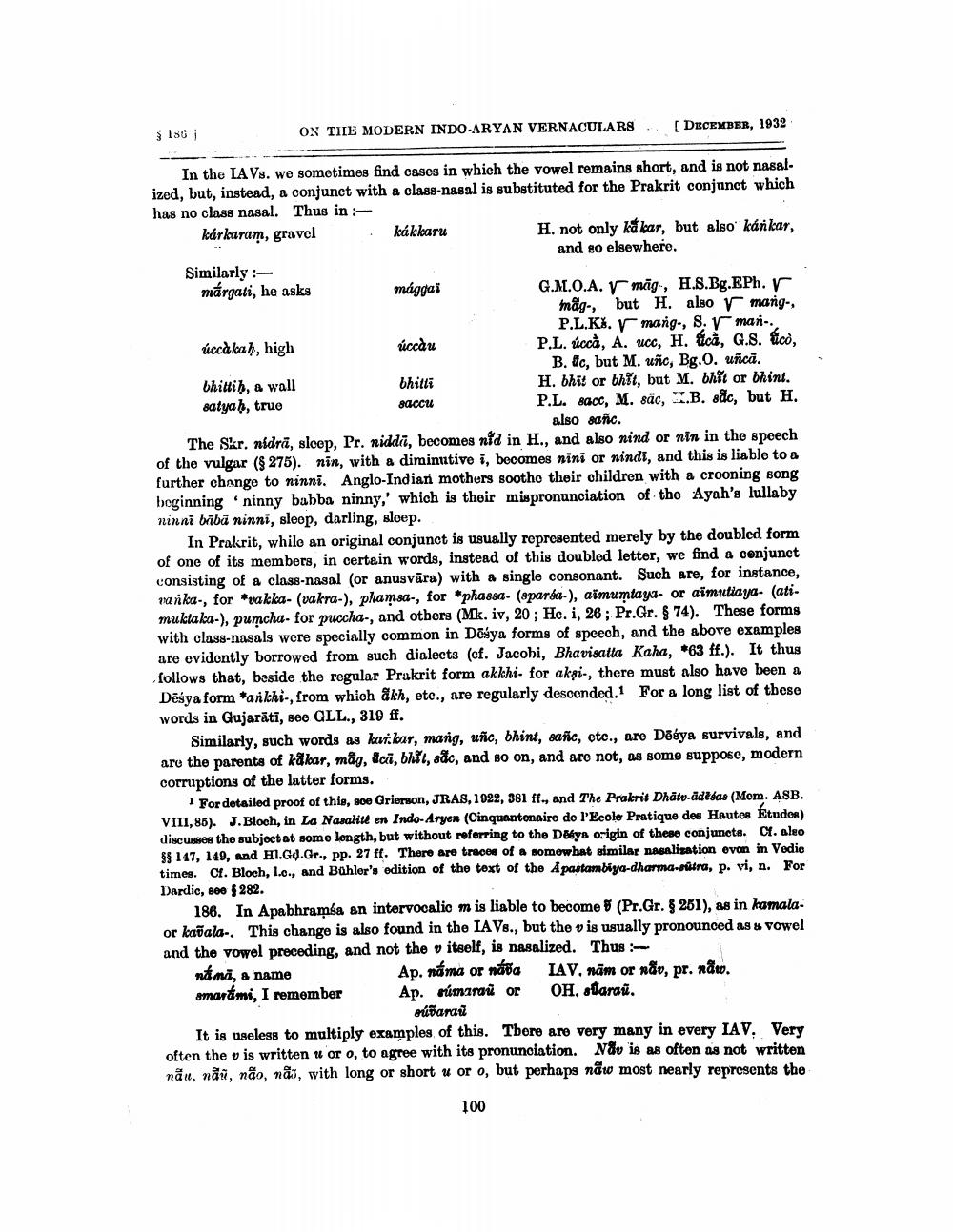________________
$150 i
ON THE MODERN INDO-ARYAN VERNACULARS.
[ DECEMBER, 1932
In the LA Vs. We sometimes find cases in which the vowel remains short, and is not nasal. ized, but, instead, a conjunct with a class-nasal is substituted for the Prakrit conjunct which has no class nasal. Thus in kárkaram, gravel
kákkaru
H. not only kd kar, but also kánkar,
and go elsewhere. Similarly :márgati, he asks
mággai
G.M.O.A. V mag-, H.S.Bg.EPh.r
mäg-, but H. also v mang-,
P.L.Kš. r mang., S. r man.. úccàkah, high
úccàu
P.L. úcca, A. ucc, H. ücà, G.8. úco,
B. ac, but M. uño, Bg.O. uncă. bhittih, a wall
bhitli
H. bhit or bhit, but M. bhit or bhint. satyaḥ, true
saccu
P.L. 80cc, M. sặc, B. sốc, bat H.
also sanc. The Skr, nidrā, sloep, Pr. niddi, becomes n'a in H., and also nind or nin in the speech of the vulgar (275). nin, with a diminutive i, becomes nini or nindi, and this is liable to a further change to ninni. Anglo-Indiari mothers soothe their children with a crooning song beginning ninny babba ninny,' which is their mispronunciation of the Ayah's lullaby ninni brībā ninni, sleep, darling, sloep.
In Prakrit, while an original conjunct is usually represented merely by the doubled form of one of its members, in certain words, instead of this doublod letter, we find a conjunct consisting of a class-nasal (or anusvāra) with a single consonant. Such are, for instance, varika-, for *vakka- (vakra-), phamsa-, for *pha880- (sparsa-), aimumtays. or aimutiaya- (ati. muktaka-), pumcha-for puccha., and others (Mk. iv, 20; Hc. i, 26; Pr.Gr. 74). These forms with class-nasals were specially common in Deśya forms of speech, and the above examples are evidently borrowed from such dialects (cf. Jacobi, Bhavisatla Kaha, *63 ff.). It thus follows that, beside the regular Prakrit form akkhi- for aksi-, there must also have been a Dēśya form *ankhi-, from which akh, etc., are regularly desocnded.1 For a long list of these words in Gujarāti, see GLL., 319 ff.
Similarly, such words as karikar, mang, unc, bhint, safic, etc., are Desya survivals, and are the parents of kikar, mag, dca, bhit, såc, and so on, and are not, as some suppose, modern corruptions of the latter forms.
For detailed proof of this, soe Grierson, JRAS, 1022, 381 ff., and The Prakrit Dhātu.adadas (Mom. ASB. VIII, 85). J. Bloch, in La Nasalik en Indo-Aryen (Cinquantenaire de l'Ecole Pratique des Hautes Etudos) discusses the subject at some length, but without referring to the Deya origin of these conjuncts. C4. also $ 147, 149, and Hl.G4.Gr., pp. 27 ff. There are traces of a somewhat similar nasalisation even in Vedic times. Cf. Bloch, 1.o., and Buhler's edition of the text of the A pastambiya-dharma sutra, p. vi, n. For Dardic, see $282.
186. In Apabhramsa an intervocalic m is liable to become $ (Pr.Gr. 8 201), as in kamalaor kavala.. This change is also found in the LAV8., but the v is usually pronounced as a vowel and the vowel preceding, and not the v itself, is nasalized. Thus náma, a name
Ap. náma or náva AV, nām or nav, pr. nat. amarámi, I remember Ap. rúmarai or OH. alaran.
orúðarau It is useless to multiply examples of this. There are very many in every IAV. Very often the v is written u or o, to agree with its pronunciation. Ndv is as often as not written nau, nai, não, nãs, with long or short u or o, but perhaps nãw most nearly represents the
100




